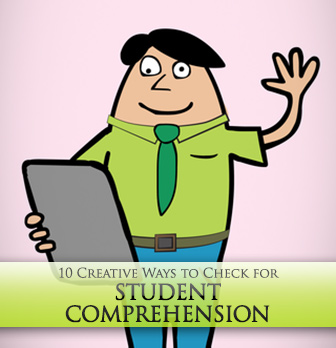
Quizzes. Tests. Projects. We’re all familiar with the formal ways to assess student learning at the end of a unit, but what about at the end of a class?
When is it a good time to move on? When should we stay in this topic and review a bit slower? We can ask our students. “Does this make sense?” We may get a few brave students willing to say no, but mostly it will be silence which we will then take as boredom and likely move on. But, did they get it? Here are some ways to check for your students’ comprehension of the lesson objectives:

Try These 10 Creative Ways to Check for Student Comprehension
-
1
Keep a Learning Journal
Throughout the year, have students keep a comprehension journal. At the end of a particularly challenging lesson or at the end of a unit, give them time at the end of a lesson to write down their understanding of the lesson of the day. Periodically collect these and review to see if students are understanding what you need them to before deciding what to do the next day. These journals can be used as often or as little as you like. Using a journal will help keep all of their information in one place and can serve as a way for them to go back and review what they’ve learned throughout the term. Students can also exchange journals with each other from time to time and give feedback to one another.
-
2
Exit Slip
A more simplified comprehension check is an exit slip. Before students leave, ask them to jot down a few things they learned in the lesson or to summarize the important points of the days’ lesson. Encourage them also to list any questions they might have. You can then look over these exit slips to determine if and what you need to review or if you can move on.
-
3
Daily Warm ups – Bell Ringers
A way to get students working right a way is to have a review question from the previous day on the board, document camera, computer etc… ready for students to do as they come in. Consider a short fill in the blank, example, or other question that you might have on an exam for them to practice. Discuss it in class after everyone arrives to activate the information they learned yesterday and prepare them for the day’s lesson. Not only will you have a bridge from the previous lesson, but you will be able to transition quickly into your teaching without trying to get all your students to settle down or focus.
-
4
Pair and Teach
Teaching someone else new information is a great way to review and solidify what you have learned. At the end of class or at the beginning of the next day, pair students together and have one student be “the teacher.” They should review the lesson with their partner by explaining and summarizing all of the main points. The partner must think of at least two questions to ask their “teacher.” Have students switch partners and then switch roles so each student gets to be the teacher and practice explaining.
If you don’t have time in class, get students’ parents or friends involved and tell your students that they must find someone not in the class to explain the day’s lesson. Have this person sign their notebook to show that they did their homework.
-
5
Tell me How You Feel
Give students five cards with their names on the back of each card to keep in their notebooks. Each card should have a corresponding ranking (either a number or a smiley face) that indicates their comprehension/comfort level with this particular topic (e.g., a scale from 1 = totally confused to 5= easy; ready to move on). After any particular lesson, ask students to choose one card that describes how they feel about that particular lesson and leave it face down on your desk as they leave the room. No one will have to know which number they gave so students can feel comfortable enough to be honest about their comprehension level. The next day you can return the cards and use them again whenever you need to.
-
6
Guided Questioning
The simplest and most effective way is to randomly ask students questions to sum up or review at the end of class. Use popsicle sticks or something with students’ names written on it so that you can be sure to get each and every student. Ask students for examples and be sure they can explain why the answered the way they did.
-
7
Let Students Write Notes on the Board
At the end of class or at the beginning of the following class, give each student a board marker and an opportunity to write something that they learned on the board. This can be a fact, rule, or an example. For instance, if we have been studying adjective clauses, Student X might write “A clause = Subject + Verb;” Student Y may write “You use ‘who’ for people and ‘which’ for things;” and Student Z may write “I know the student who wrote this sentence.”
After all students have had a chance, you have a board full of information about what you learned and your students feel as though they have contributed greatly. This is a great time for student collaboration as they help each other write their facts on the board, and you can observe which students are struggling. After all of the facts have been written, as a class you can review and correct any misrepresented information.
Variation: For a faster approach, arrange the students in a circle and toss around a ball or soft object. When the ball comes to them, students must say their fact or example out loud.
-
8
Concept Mapping
Students learn best when they can associate new material to things they have already learned. Have students reflect on the new topic they’ve learned and ask them to group it or relate it to a previously studied topic or something else they know about English. For example, if they have been learning adjective clauses, they might say how similar adjective clauses look to WH questions because they both use who/where/when/which/whose. Give students create Venn diagrams or concept maps to link related topics or highlight differences between them.
-
9
Reflection at Home
Often students think they understand while they are in class in the presence of their teacher, but when they go home, they find they didn’t understand everything while trying to do their homework. Have students reflect at home to get a more realistic idea of what they comprehended. They could do a learning journal or you can involve technology. Create anonymous surveys (using sites like surveymonkey.com or the class management site Edmodo) and ask students how they feel about their grasp of the topic.
-
q
Error Correction / Problem-solving
Pose a problem or editing task on the board or for homework. Instruct students that when they answer, they need to give a step-by-step analysis of what they were thinking when they chose the correct answer, similar to showing your work when doing a math problem. For example, I gave my students this fill in the blank question about adjective clauses: I like Mr. Smith _______________ works down the street. Their task was to choose the correct relative pronoun and punctuation to fill in the blank. An analysis I might expect from a student would look something like this “Mr. Smith is a person => who or that. Mr. Smith is a name => non-essential adjective clause. Non-essential clauses= who (NO that) and comma because it’s extra information so it needs extra punctuation. Final answer= , who.”
This works best if they can explain their solution orally by voice recording (using sites like Voice Thread and their cell phones, iPads, or taking a video on their computer) or talking with students one-on-one. However, if students don’t have the technology to record themselves, encourage them to write it out in bullet form.
Even the best-planned lessons can become ineffective if the students don’t comprehend the material.
Knowing where each of your students is struggling is the key to helping them be successful, even if you’re teaching a large class. Try a few of these ways in your next lesson to see how the material has been received!
P.S. If you enjoyed this article, please help spread it by clicking one of those sharing buttons below. And if you are interested in more, you should follow our Facebook page where we share more about creative, non-boring ways to teach English.







